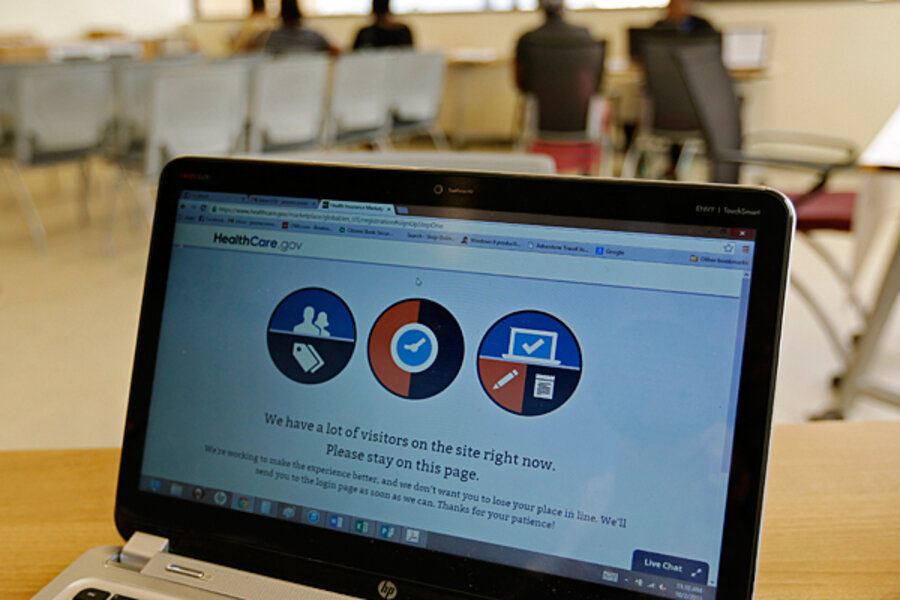Beyond Obamacare glitches, some consumers face dramatically higher rates
Loading...
| Washington
Problems with the main "Obamacare" website, HealthCare.gov, have dominated headlines since the site opened for business on Oct. 1.
But another problem is surfacing: Some consumers who have been buying their own insurance are getting cancellation notices – and offers for insurance at dramatically higher rates.
There are multiple reasons this is happening. First, the Affordable Care Act (ACA) sets minimum standards for benefits, including mental-health and substance-abuse treatment, maternity care, prescription drugs, and rehabilitative care, which were not included in many of the old plans. Also, insurance companies are now required to take all comers, regardless of their health status, and so rates are rising to cover their costs as well.
In the debate before the ACA passed, there was plenty of focus on people who lacked insurance, either because they couldn’t afford it or had a preexisting condition. Now, newspapers around the country are chronicling the stories of the other category of consumer – people who make too much money to be eligible for federal subsidies and are being charged double and triple their old rates.
"The upper-middle class are the people who are essentially being asked to foot the bill, and that's true across the country,” Jonathan Wu, cofounder of ValuePenguin, a consumer finance website, tells the San Jose Mercury News.
Michael Yount of Charlotte, N.C., is one such unhappy customer. He and his wife, retired and in their late 50s, have been buying their own health insurance from Blue Cross and Blue Shield (BCBS) in North Carolina, paying about $380 a month with an $11,000 deductible. BCBS is offering them a new plan for three times the cost, $1,124.50 a month, still with an $11,000 deductible.
“We are an insurance company’s dream,” Mr. Yount tells the Monitor. “We pay our bills, we hardly ever get sick, no prescription drugs. And now this.”
Reluctantly, he says, they plan to drop out of formal health insurance, pay the penalty, and “self-insure.”
“No question, there’s risk there,” Yount says. “The question is, how much are you willing to pay someone else to mitigate that risk?”
He also understands that the law is meant to help those who have not been able to buy insurance because of preexisting conditions. But he objects to how it’s being done.
“If the only way to get it to them is forcibly taking it from everybody else, how is that any better?” Yount says. “I’m struggling with what is the greater evil and injustice. I don’t think it’s any more right to take it from one person forcibly. It’s coercion.”
Yount has been trying since Oct. 1 to get onto HealthCare.gov to see what his options are on the federal exchange, but with no success.
Indeed, after undergoing repairs over the weekend, HealthCare.gov is still experiencing significant difficulties. When the problems first became apparent, after open enrollment began on Oct. 1, administration officials blamed high traffic – a sign of the high demand from among the millions of Americans who have been unable to buy insurance until now.
Joanne Peters, spokeswoman for the Department of Health and Human Services (HHS), says the repair work is “beginning to show results.”
“Call center wait times are seconds, not minutes, and people have been enrolling over the phone 24/7,” Ms. Peters said Monday in an e-mailed statement. “Our work to expand the site’s capacity has led to more people successfully applying for and enrolling in affordable health coverage online, with wait times being shortened by approximately 50 percent since Friday. But we won’t stop until the doors to HealthCare.gov are wide open, and at the end of the six-month open enrollment, millions of Americans gain affordable coverage.”
But technical experts say the problems are about more than just capacity and that the site needs design changes.
“The website is troubled by coding problems and flaws in the architecture of the system,” The Wall Street Journal reported on Sunday, citing the conclusions of insurance-industry advisers, technical experts, and people close to the development of the marketplace.
Health-insurance consultants who have been tracking the rollout of the ACA say that if HealthCare.gov is not functioning smoothly by early November, the enrollment backlog will become critical. To be covered by Jan. 1, when the law’s mandate for individuals to carry insurance goes into effect, one must have signed up by Dec. 15.
HealthCare.gov services 36 states. The other 14 states plus the District of Columbia are running their own health-insurance exchanges, and while some have not had widespread problems – such as in Kentucky and Connecticut – others, like Maryland, have. The only way to be eligible for a federal subsidy is to buy insurance through one of the government exchanges.
A postscript from Michael Yount of Charlotte: He got back in touch to say that if he or his wife were to become ill, then they would buy health insurance – since the plans are now barred from turning anyone away.
One problem with that idea is that people can buy insurance on the government exchange only during the open enrollment period. In the first year, it goes from Oct 1, 2013, to March 31, 2014. Enrollment reopens on Oct. 7, 2014. So what happens if Yount or his wife get sick or have an accident during the “blackout” period?
“As we discussed – there is risk,” Yount says in an e-mail. “But the odds are that the most likely scenario for a major medical problem is a car accident. That's covered with my auto insurance.”
And in the event of an expensive illness, he says, “we spin the wheel.”








